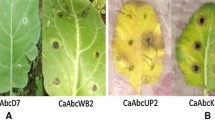Abstract
Nitrate non-utilising (Nit) mutants of six field strains and three single-ascospore strains of Botryotinia fuckeliana were selected by plating mycelial plugs onto a nitrate-containing minimal medium amended with chlorate. Mutants were characterised by growth responses on minimal medium amended with various sole nitrogen sources. For each parental strain two mutants were produced: nit1, defective in nitrate reductase apoenzyme; and NitM, defective in the molybdenum cofactor pathway. Complementation on nitrate minimal medium was observed between nit1 and NitM mutants from the same parent in all instances. However, complementation was not observed between any such combinations when the mutants were derived from different parents. It is concluded that a vegetative incompatibility system operates in B. fuckeliana resulting in multiple vegetative compatibility groups. One of the single-ascospore strains was derived from a cross between two of the field strains, indicating that new compatibility groups can be generated during sexual reproduction. Mycelial interaction zones were formed between all parental strains when they were paired on NaCl-amended medium, indicating congruence between mycelial incompatibility and vegetative incompatibility.
Similar content being viewed by others
References
Alfonso C, Raposo R and Melgarejo P (2000) Genetic diversity in Botrytis cinerea populations on vegetable crops in greenhouses in south-eastern Spain. Plant Pathology 49: 243-251
Beever RE and Parkes SL (1993) Mating behaviour and genetics of fungicide resistance of Botrytis cinerea in New Zealand. New Zealand Journal of Crop and Horticultural Science 21: 303-310
Brooker NL, Leslie JF and Dickman MB (1991) Nitrate non-utilizing mutants of Colletotrichum and their use in studies of vegetative compatibility and genetic relatedness. Phytopathology 81: 672-677
Coley-Smith JR, Verhoeff K and Jarvis WR (1980) The Biology of Botrytis, Academic Press, London, UK
Correll JC, Klittich CJR and Leslie JF (1987) Nitrate nonutilizing mutants of Fusarium oxysporum and their use in vegetative compatibility tests. Phytopathology 77: 1640-1646
Correll JC and Gordon TR (1999) Population structure of ascomycetes and deuteromycetes. What we have learned from case studies. In: Worrall JJ (ed) Structure and Dynamics of Fungal Populations (pp 225-250) Kluwer, Dordrecht, the Netherlands
Delc´an J and Melgarejo P (2002) Mating behaviour and vegetative compatibility in Spanish populations of Botrytotinia fuckeliana. European Journal of Plant Pathology 108: 391-400
Faretra F and Pollastro S (1993) Genetics of sexual compatibility and resistance to benzimidazole and dicarboximide fungicides in isolates of Botryotinia fuckeliana (Botrytis cinerea) from nine countries. Plant Pathology 42: 48-57
Ford EJ, Miller RV, Gray H and Sherwood JE (1995) Heterokaryon formation and vegetative compatibility in Sclerotinia sclerotiorum. Mycological Research 99: 241-247
Giraud T, Fortini D, Levis C, Leroux P and Brygoo Y (1997) RFLP markers show genetic recombination in Botryotinia fuckeliana (Botrytis cinerea) and transposable elements reveal two sympatric species. Molecular Biology and Evolution 14: 1177-1185
Giraud T, Fortini D, Levis C, Lamarque C, Leroux P, LoBuglio K and Brygoo Y (1999) Two sibling species of the Botrytis cinerea complex, transposa and vacuma, are found in sympatry on numerous host plants. Phytopathology 89: 967-973
Glass NL, Jacobson, DJ and Shiu PKT (2000) The genetics of hyphal fusion and vegetative incompatibility in filamentous ascomycete fungi. Annual Review of Genetics 34: 165-186
Grindle M (1979) Phenotypic differences between natural and induced variants of Botrytis cinerea. Journal of General Microbiology 111: 109-120
Hansen HN and Smith RE (1932) The mechanism of variation in imperfect fungi: Botrytis cinerea. Phytopathology 22: 953-964
Howitt RLJ, Beever RE, Pearson MN and Forster RLS (1995) Presence of double-stranded RNA and virus-like particles in Botrytis cinerea. Mycological Research 99: 1472-1478
Huang J, Hsieh T-F, Chastagner GA and Hsiang T (2001) Clonal and sexual propagation in Botrytis elliptica. Mycological Research 105: 833-842
Kerssies A, Bosker-van Zessen AI, Wagemakers CAM and van Kan JAL (1997) Variation in pathogenicity and DNA polymorphism among Botrytis cinerea isolates sampled inside and outside a glasshouse. Plant Disease 81: 781-786
Leslie JF (1993) Fungal vegetative compatibility. Annual Review of Phytopathology 31: 127-150
Levis C, Fortini D and Brygoo Y (1997) Transformation of Botrytis cinerea with the nitrate reductase gene (niaD) shows a high frequency of homologous transformation. Current Genetics 32: 157-162
Lorbeer JW (1980) Variation in Botrytis and Botryotinia. In: Coley-Smith JR, Verhoeff K and Jarvis WR (eds) The Biology of Botrytis (pp 19-39) Academic Press, London, UK
Malik M and Vilgalys R (1999) Somatic incompatibility in fungi. In: Worrall JJ (ed) Structure and Dynamics of Fungal Populations (pp 123-138) Kluwer, Dordrecht, the Netherlands
Menzinger W (1966) Zur Variabilität und Taxonomie von Arten und Formen der Gattung Botrytis Mich. II. Untersuchen zur Variabilität des Kulturtyps unter konstanten Kulturbedingungen. Zentralblatt fur Bakteriologie, Parasitenkunde, Infektionskskrankheiten und Hygiene 120: 179-196
Paul WRC (1929) A comparative morphological and physiological study of a number of strains of Botrytis cinerea Pers. with special reference to their virulence. Transactions of the British Mycological Society 14: 118-135
Perkins DD (1977) Details for preparing silica gel stocks. Neurospora Newsletter 24: 16-17
Saup SJ (2000) Molecular genetics of heterokaryon incompatibility in filamentous ascomycetes. Microbiology and Molecular Biology Reviews 64: 489-502
Thompson JR and Latoree BA (1999) Characterization of Botrytis cinerea from table grapes in Chile using RAPD-PCR. Plant Disease 83: 1090-1094
Vogel HJ (1964) Distribution of lysine pathways among fungi: Evolutionary implications. The American Naturalist 98: 435-446
Van der Vlugt-Bergmans CJB, Brandwagt BF, Van't Klooster JW, Wagemakers CAM and Van Kan JAL (1993) Genetic variation and segregation of DNA polymorphisms in Botrytis cinerea. Mycological Research 97: 1193-1200
Weeds PL, Beever RE and Long PG (1998) New genetic markers for Botrytis cinerea (Botryotinia fuckeliana). Mycological Research 102: 791-800
White GJ, Dobinson K and Traquair JA (1998) Selection of nitrate-nonutilizing mutants in Verticillium, Alternaria, and Botrytis. Canadian Journal of Plant Pathology 20: 340
Author information
Authors and Affiliations
Rights and permissions
About this article
Cite this article
Beever, R.E., Parkes, S.L. Use of nitrate non-utilising (Nit) mutants to determine vegetative compatibility in Botryotinia fuckeliana (Botrytis cinerea) . European Journal of Plant Pathology 109, 607–613 (2003). https://doi.org/10.1023/A:1024732815134
Issue Date:
DOI: https://doi.org/10.1023/A:1024732815134




